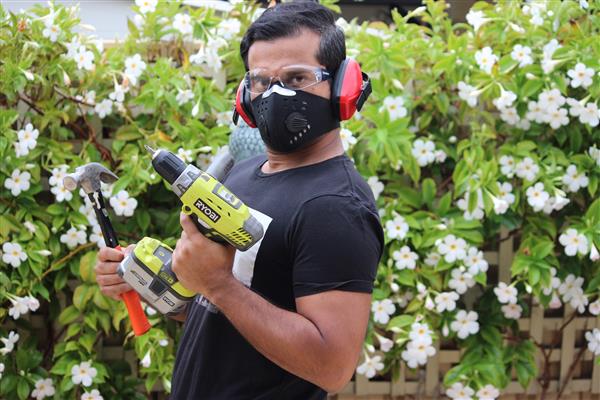Тестер стабилитронов
Тестер стабилитронов как отдельный прибор, так и приставка к карманному осциллографу Хамелеон D.
Конструкция собрана в корпусе китайского маркера, щупы бронзовые контакты от реле с напаянными для жёсткости пластинками из фольгированного стеклотекстолита.
Чтобы определить и рассортировать эти диоды, и создан этот тестер.
Этим прибором можно найти истинное напряжение стабилизации и ток, при котором стабилитрон начинает стабилизировать напряжение.
Проверяемые стабилитроны до 27V при токе 1-30mА.
Потребляемый ток без подключения измеряемого стабилитрона около 80мА.
Теперь, как это всё работает.
Источник высокого напряжения 36V собран по стандартной схеме на MC34063A. Регулируемый ШИМом драйвер собран на усечённой версии ОУ TL431 (хочу заметить без лишней скромности – такое включение моё ноу-хау и нигде вроде не наблюдалось). Управляет и отображает информацию на стандартный ЖКИ с контроллером HD44780 или на дисплей Хамелеона микроконтроллер Mega8.
На щупы попеременно подаём импульсы разной полярности амплитудой 1.2V и постоянно следим за амплитудой. При подключении исследуемого диода, происходит просадка до прямого напряжения через него, менее 0.8V. По этому факту автоматически запускается цикл измерения параметров. Увеличиваем с помощью ШИМ напряжение на стабилитроне от нуля, пока не увеличится напряжение на измерительном резисторе 120 Ом до установленной величины тока стабилитрона. Теперь меряем напряжение Uпрям и Uобрат. Программно меняем полярность подключения диода на обратную, опять проводим цикл измерения, определяем класс диода и выводим данные на дисплей обычным способом командой printf.
По умолчанию измерения проводятся на токе 5mA, менять значения тока можно короткими нажатиями кнопок от 1 до 30mA . Длительным нажатим верхней кнопки при подключённом стабилитроне входим в режим калибровки, при свободных щупах длительное нажатие сохраняет в ЕЕПРОМ текущее значения тока и калибровочное значение VREF. Длительное нажатие нижней кнопки принудительно запускает процесс измерения, эту нужно для диодов, не имеющих падения напряжения в прямом включении, например стабилитрон с диодом, двойной стабилитрон.
В Хамелеоне зарезервирован буфер на 62 символа, первый и последний служебные, остальные 60 символов жёстко привязаны к своим местам – 4 строки по 10 символов и одна 20 символов.
Очистки экрана нет, потому надо передавать строку длиной 62 символа, заполняя пустые места пробелами.
Так выглядит передаваемая строка в CodeVisionAVR
printf("#анод* Uст %2i.%-2iвUпр %2i.%-2iвкатод*%2imAСтабилитрон r", pp2,p2,pp1,p1,out_cur[a]); //передаём в УАРТ
Подключение к Хамелеону через стандартный шнур USB -> miniUSB, от него же получаем питание для тестера.
Настройка заключается в подгонке параметра опорного напряжения VREF. Для этого измеряется Uстаб любого стабилитрона в простейшей схеме с последовательным резистором при заданном токе. Потом выставляем требуемый ток на данном тестере, подключаем этот стабилитрон к щупам, входим в режим калибровки и подгоняем результат изменением значения VREF на дисплее. Отключаем стабилитрон, значение VREF автоматически сохраняется. Или просто выставляем измеренное значение на 20 ножке AREF.
Плата разрабатывалась как пинцет-приставка для Хамелеона D, но можно непосредственно подключить ЖКИ, на плате уже есть контактные площадки.
https://www.radiokot.ru/forum/viewtopic.php?t=55467
https://radiokot.ru/circuit/digital/measure/52/
Zener diode tester as a separate device, as well as a prefix to a pocket oscilloscope Chameleon D.
The design is assembled in the housing of the Chinese marker, the probes are bronze contacts from the relay with foil fiberglass plates soldered for stiffness.
To identify and sort these diodes, this tester was created.
With this device, you can find the true stabilization voltage and the current at which the zener diode begins to stabilize the voltage.
Checked zener diodes up to 27V at a current of 1-30mA.
The current consumption without connecting the measured zener diode is about 80mA.
Now, how does it all work.
The 36V high voltage source is assembled according to the standard circuit on the MC34063A. The driver regulated by the PWM is assembled on a truncated version of the TL431 op-amp (I want to note without too much modesty - such inclusion of my know-how has never been seen anywhere else). It controls and displays information on a standard LCD with an HD44780 controller or on a Chameleon display with a Mega8 microcontroller.
The probes alternately supply pulses of different polarity with an amplitude of 1.2V and constantly monitor the amplitude. When the diode under investigation is connected, there is a drawdown to a direct voltage through it, less than 0.8V. On this fact, a cycle of measuring parameters is automatically started. Using PWM, we increase the voltage at the zener diode from zero until the voltage at the measuring resistor increases to 120 Ω to the set value of the zener current. Now we measure the voltage U direct and U back. Programmatically change the polarity of the diode connection to the opposite, again carry out a measurement cycle, determine the diode class and display the data on the display in the usual way with the printf command.
By default, measurements are carried out at a current of 5mA; current values ??can be changed by short presses of buttons from 1 to 30mA. Long press the top button when the zener diode is connected, we enter the calibration mode, with free probes, a long press saves the current current values ??and the calibration value VREF in EEPROM. A long press of the bottom button forces the measurement process, this is necessary for diodes that do not have a voltage drop in direct connection, for example a zener diode with a diode, a double zener diode.
A buffer for 62 characters is reserved in the Chameleon, the first and last service, the remaining 60 characters are rigidly tied to their places - 4 lines of 10 characters and one 20 characters.
There is no screen cleaning, so you need to transfer a string of 62 characters in length, filling in the empty spaces with spaces.
This is what the transmitted string looks like in CodeVisionAVR
printf ("# anode * Ust% 2i.% - 2iUUpr% 2i.% - 2ivkatode *% 2imA Zener diode r", pp2, p2, pp1, p1, out_cur [a]); // pass to UART
Connecting to the Chameleon via a standard USB cable -> miniUSB, we get power for the tester from it.
The setting is to adjust the VREF reference voltage parameter. For this, the Ustab of any zener diode is measured in the simplest circuit with a series resistor at a given current. Then we set the required current on this tester, connect this zener diode to the probes, enter the calibration mode and adjust the result by changing the VREF value on the display. Turn off the zener diode, the VREF value is automatically saved. Or just set the measured value on the 20 AREF leg.
The board was designed as a tweezer attachment for Chameleon D, but you can directly connect the LCD, the board already has contact pads.
Тестер стабилитронов
*PCBWay community is a sharing platform. We are not responsible for any design issues and parameter issues (board thickness, surface finish, etc.) you choose.
- Comments(0)
- Likes(3)
- 2 USER VOTES
- YOUR VOTE 0.00 0.00
- 1
- 2
- 3
- 4
- 5
- 6
- 7
- 8
- 9
- 10
- 1
- 2
- 3
- 4
- 5
- 6
- 7
- 8
- 9
- 10
- 1
- 2
- 3
- 4
- 5
- 6
- 7
- 8
- 9
- 10
- 1
- 2
- 3
- 4
- 5
- 6
- 7
- 8
- 9
- 10

-
10design
-
10usability
-
10creativity
-
10content
-
10design
-
10usability
-
10creativity
-
10content
 More by Engineer
More by Engineer
-
-
-
-
-
-
3D printed Enclosure Backplate for Riden RD60xx power supplies
154 1 1 -
-








































